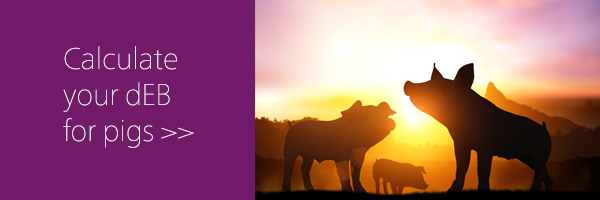Things to consider when working with buffer capacity
Curious to know more about buffer capacity of feed? Here you find all the questions and answers from the webinar by Dr. Sofia Rengman.
- What is the ProPhorce™ AC 299 abc4 value?
It is approximately 2900 (variation 2800-3000) -
How does the ProPhorce™ AC 200 or ProPhorce™ AC 299 interact with Vitamins in a premix or is it better to add it separately when mixing feed?
ProPhorce™ AC 200 can be added either to the premix or the feed itself. To be safe we recommend to add ProPhorce™ AC 299 to the feed. If you would like to add it directly to the premix we recommend that you do a test batch first to evaluate if/how it reacts with the specific ingredients that are used in your premix. - Do you have more detailed data for ABC-4 for different feed materials?
The best free available source I know of is: Lawlor P.G., Lynch P.B., Caffrey J.P., O Reilly J.O., O Conell M.K., “Measurements of the acid-binding capacity of ingredients used in pig diets”. Irish Veterinary Journal., Vol 58 (8)., 2005. - Do you have information if different processing (for instance extruding) influence buffering capacity?
Unfortunately not. The ingredients are the same but due to the heat in the process, chemical reactions will take place which might alter the buffer capacity a bit. However limestone and sodium bicarbonate are very heat resistant and withstand temperatures up to at least up 300 °C so the buffering effect of the salts will remain. - Do you have experience about farmed rabbits? In addition, for a rabbit the gastric Ph it's 2,5-3, the utilization of calcium formate can be a "solution" for maintain low the value of Ph?
We have some experience with feed for farmed rabbits but it is not our main area of expertise. Rabbits have a very sensitive gastro-intestinal system. I most mammals the production and release of gastric acid is in most mammals triggered via the vagus nerve in association of feed intake. This is not the case with e.g. rabbits and horses. They do not have a vagus regulated output of gastric acid. Instead they have a small but constant output of gastric acid to go along with a small but almost constant intake of roughage. Feeding larger meals, maybe with rather high protein and mineral content to optimize growth, is likely to cause digestive problems. According to my knowledge it could be a good strategy to reduce the buffering capacity of the feed also for rabbits and not only young pigs. I have no trials on using Calcium Formate in rabbit diets but theoretically it could be a good option. - Shouldn't you calculate with ABC 3 for mature piglets, because than the activite of Pepsinogen - Pepsin starts?
It does not matter that much if you use ABC-3 or ABC-4 as long as you only compare values within the same set pH (3 or 4). Both set of pHs are used in literature to compare the Acid binding capacity of different feed ingredients. I agree that ABC-3 can be of higher physiological interest in many cases but that ABC-4 can be of more practical relevance.
Pepsinogen is produced by the Chief-cells in the stomach and when Pepsinogen comes into contact with HCl it is activated into Pepsin, a protease involved in the pre-digestion of protein. The activation is effective at pH 3. A second order activation, pepsin-catalyzed, occurs at pH 3-4.5. The pre-digestion of protein by Pepsin is most efficient at pH 2-3, when pH increase above 4 the efficiency of pepsin rapidly decline. - What is the optimal buffer capacity of piglet feed 6 - 12 kg and 12 - 20kg?
The goal should be a feed with an ABC-3 value below 650 mEq/Kg. - Why should you add cafo and not pure formic acid?
To reduce the buffer capacity of the diet you preferably use formic acid or an organic acid blend.
The diet usually also need a calcium source and different sources have different buffering values, limestone has a high value, calcium formate has a much lower value and is a better choice if you want to reduce the buffering capacity of the feed - What about using monocalcium phosphate?
Mono calcium phosphate (MCP) or di calcium phosphate (DCP) is commonly used to provide Calcium an Phosphorous to die diet. From a feed buffering perspective MCP and DCP have the approximate ABC-4 values of 291 vs 3100 so preferably use MCP. On top of that there is usually a need for more calcium to reach the optimal Ca:P ratio for the diet.
This Calcium can come from different sources, usually limestone but can also come from Calcium formate or, as was stated from a person in the audience, calcium acetate. Limestone will increase the buffering capacity of the feed while formate or acetate calcium salts will have less effect on the buffering capacity. The formate and acetate ions may also exert a bacteriostatic effect. A commonly used solution is to use a formic acid based feed acidifier together with Calcium formate to fulfill both the acidification and the calcium need of the diet. - Using calcium formate or calcium acetate?
Both of these Calcium salts will have less impact on feed buffering capacity compared to limestone. Both provide highly available calcium and the anions (acetate or formate) have the possibility to stay as they are or react with a hydrogen ion to form acetic acid or formic acid in the stomach. SCFA are known to have bacteriostatic effect where formic acid usually have the strongest effect. - How do calcium formate and limestone differ in effect on phytase functionality?
In general, feed additive phytases work well in the pH range of pH 3-6. You need to get the data for the specific phytase you use to learn more about how pH affects the efficiency of the phytase.
Calcium formate do not particularly increase feed pH and the feed buffer effect while limestone have a high buffering effect and increase the total feed buffering effect when included in the feed. This increases the risk that you come close to the upper pH limit for the phytase activity range. Ask your Phytase provider for more information. - Is Ca not also a positive element in the dEB like Na, however we never take it into account?
Ca2+ is a cation that will have a minor effect on the dEB, but not of a magnitude that it is necessary to include Ca in the equation. The reasons for this is, divalent cations have less impact on the blood pH than monovalent cations. Most of the calcium in the blood is bound to transport proteins fx serum albumin. The amount of ionized Ca2+ (the physiological relevant form) is just a couple of % compared to the amount of ionized Na+ so the dEB impact of Calcium is negligible. - When calculate with Sulphate for dEB, should you calculate with organic / inorganic / both?
Both. - Can I improve feed intake at lactating sows, by decreasing ABC in the feed. Is there a reduced transition time in stomach?
Lactating sows has a mature gastro-intestinal tract, produce sufficient amount of gastric HCl and are well equipped to digest and absorb solid feed. I think the buffering effect will be of less importance when it comes to increase feed intake during lactation. Other factors such as genetics, parity, sow body condition, feeding strategy, lactation length, litter size and litter weight will be of greater importance. When it comes to the diet the most important thing is nutrient composition and nutrient and energy density. Feeding two or more times per day may improve feed intake.


